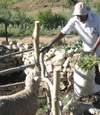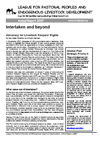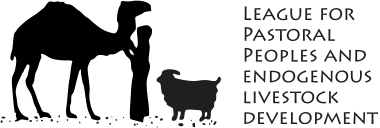Role of livestock keepers in the Global Plan of Action

LPP member Evelyn Mathias gave a presentation on the role of livestock keepers in the conservation of farm animal diversity and the Global Plan of Action for Animal Genetic Resources at a meeting of European national coordinators on animal genetic resources in Vilnius, Lithuania, on 21 August 2008.
Click here to view her presentation 151 kb.
LPP 2007 annual report

The 2007 Annual Report of the League for Pastoral Peoples and Endogenous Livestock Development is now available here.
The lead article describes the League’s role in advocacy for Livestock Keepers’ Rights.
“Intellectual property rights on animal genetic resources are an issue that is now on the international agenda”, says the report. “Due to the Livestock Keepers’ Rights movement, pastoralists and other livestock keepers will be seen as legitimate stakeholders with an interest in policy development regarding intellectual property rights on animal genetic resources. Much remains to ensure they are automatically involved in such decision making, but we are on the right road.”
Biofuels in drylands threaten pastoralists
High fuel prices have boosted interest in growing crops such as jatropha on sparsely populated drylands. But these lands are not empty: they are home, and vital grazing, for millions of pastoralists around the world.
This press release, issued on the World Day to Combat Desertification, draws attention to this new threat.
Download 38 kb
- Go to the previous page
- 1
- …
- 58
- 59
- 60
- 61
- 62
- 63
- 64
- …
- 86
- Go to the next page
